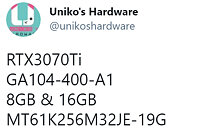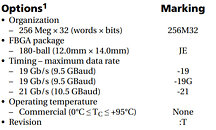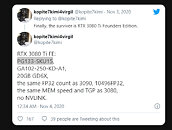
NVIDIA Readying GeForce RTX 3090 SUPER, A Fully Unlocked GA102 with 400W Power?
NVIDIA is readying the GeForce RTX 3090 SUPER, the first "SUPER" series model from the RTX 30-series, following a recent round of "Ti" refreshes for its product stack. According to kopite7kimi and Greymon55, who each have a high strike-rate with NVIDIA rumors, the RTX 3090 SUPER could finally max-out the 8 nm "GA102" silicon on which nearly all high-end models from this NVIDIA GeForce generation are based. A fully unlocked GA102 comes with 10,752 CUDA cores, 336 Tensor cores, 84 RT cores, 336 TMUs, and 112 ROPs. The RTX 3090 stops short of maxing this out, with its 10,496 CUDA cores.
NVIDIA's strategy with the alleged RTX 3090 SUPER will be to not only max out the GA102 silicon, with its 10,752 CUDA cores, but also equip it with the fastest possible GDDR6X memory variant, which ticks at 21 Gbps data-rate, compared to 19.5 Gbps on the RTX 3090, and 19 Gbps on the RTX 3080 and RTX 3080 Ti. At this speed, across the chip's 384-bit wide memory bus, the RTX 3090 SUPER will enjoy 1 TB/s of memory bandwidth. Besides more CUDA cores, it's possible that the GPU Boost frequency could be increased. All this comes at a cost, though, with Greymon55 predicting a total graphics power (TGP) of at least 400 W, compared to 350 W of the RTX 3090. A product launch is expected within 2021.
NVIDIA's strategy with the alleged RTX 3090 SUPER will be to not only max out the GA102 silicon, with its 10,752 CUDA cores, but also equip it with the fastest possible GDDR6X memory variant, which ticks at 21 Gbps data-rate, compared to 19.5 Gbps on the RTX 3090, and 19 Gbps on the RTX 3080 and RTX 3080 Ti. At this speed, across the chip's 384-bit wide memory bus, the RTX 3090 SUPER will enjoy 1 TB/s of memory bandwidth. Besides more CUDA cores, it's possible that the GPU Boost frequency could be increased. All this comes at a cost, though, with Greymon55 predicting a total graphics power (TGP) of at least 400 W, compared to 350 W of the RTX 3090. A product launch is expected within 2021.




















































